Analysis of Lactation Performance and Mastitis Incidence in High- and Low-Yielding Dairy Cows Using DHI Data
Simple Summary
Abstract
1. Introduction
2. Materials and Methods
2.1. Basis and Method of Grouping
2.2. Laboratory Animals and Data Sources
2.3. Dairy Farm Rearing Environment
2.4. Data Processing
- (1)
- Records that lacked parity information were excluded;
- (2)
- Records with a milk yield of less than 1 kg were excluded;
- (3)
- Records without an SCC were excluded;
- (4)
- Records the falling outside the normal lactation days were excluded;
- (5)
- Records of cows with fewer than two consecutive DHI tests were excluded;
- (6)
- Records with SCC values exceeding the established Fossomatic SCC measurement range (1–9999 × 104 cells/mL) were also excluded.
2.5. Statistical Analysis Description
β6(DIM group × group) + β7(month × group) + (1|cow ID) + ε.
3. Results
3.1. Differences in Production Performance Between High-Yield and Low-Yield Dairy Cows During Peak Lactation
3.2. Differences in Somatic Cell Counts Between High- and Low-Yielding Dairy Cows
3.3. Factors Affecting Milk Yield Based on Multivariate Linear Regression Analysis
3.4. Analysis of Factors Affecting SCC Based on Multiple Linear Regression
3.5. Analysis of the Incidence of Clinical Mastitis
4. Discussion
5. Conclusions
Author Contributions
Funding
Institutional Review Board Statement
Informed Consent Statement
Data Availability Statement
Acknowledgments
Conflicts of Interest
Abbreviations
Appendix A
References
- Dallago, G.M.; Mauyenova, N.; Warner, D.; Cue, R.I.; Vasseur, E. Using the Herd Status Index to remotely assess the welfare status of dairy herds based on prerecorded data. Animal 2022, 16, 100641. [Google Scholar] [CrossRef] [PubMed]
- Schwarz, D.; Kleinhans, S.; Witzel, G.; Stückler, P.; Reith, F.; Danø, S. Usefulness of the total and differential somatic cell count based udder health group concept for evaluating herd management practices and udder health in dairy herds. Prev. Vet. Med. 2023, 218, 105977. [Google Scholar] [CrossRef] [PubMed]
- Neupane, M.; Hutchison, J.L.; Cole, J.B.; Van Tassell, C.P.; VanRaden, P.M. Genomic evaluation of late-term abortion in cows recorded through Dairy Herd Improvement test plans. JDS Commun. 2023, 4, 354–357. [Google Scholar] [CrossRef] [PubMed]
- Zigo, F.; Vasil, M.; Ondrašovičová, S.; Výrostková, J.; Bujok, J.; Pecka-Kielb, E. Maintaining Optimal Mammary Gland Health and Prevention of Mastitis. Front. Vet. Sci. 2021, 8, 607311. [Google Scholar] [CrossRef]
- Liu, J.; Liu, H.; Cao, G.; Cui, Y.; Wang, H.; Chen, X.; Xu, F.; Li, X. Microbiota Characterization of the Cow Mammary Gland Microenvironment and Its Association with Somatic Cell Count. Vet. Sci. 2023, 10, 699. [Google Scholar] [CrossRef] [PubMed]
- Han, Z.; Fan, Y.; Yang, Z.; Loor, J.J.; Yang, Y. Mammary Transcriptome Profile during Peak and Late Lactation Reveals Differentially Expression Genes Related to Inflammation and Immunity in Chinese Holstein. Animals 2020, 10, 510. [Google Scholar] [CrossRef] [PubMed]
- Brock, C.C.; Pempek, J.A.; Jackson-Smith, D.; Habing, G.G.; da Costa, L.; Weaver, K. Managing organic dairy herd health: Current roles and possible future roles for veterinarians with organic dairy clientele. J. Dairy Sci. 2022, 105, 8328–8341. [Google Scholar] [CrossRef] [PubMed]
- Nasr, M.A.; El-Tarabany, M.S. Impact of three THI levels on somatic cell count, milk yield and composition of multiparous Holstein cows in a subtropical region. J. Therm. Biol. 2017, 64, 73–77. [Google Scholar] [CrossRef] [PubMed]
- Firkins, J.L.; Yu, Z.; Morrison, M. Ruminal nitrogen metabolism: Perspectives for integration of microbiology and nutrition for dairy. J. Dairy Sci. 2007, 90 (Suppl. S1), E1–E16. [Google Scholar] [CrossRef] [PubMed]
- Catalina, A.L.; Reverter, A.; Alexandre, P.A.; Nguyen, L.T.; Recio, O.G. Stress-induced epigenetic effects driven by maternal lactation in dairy cattle: A comethylation network approach. Epigenetics 2024, 19, 2381856. [Google Scholar] [CrossRef] [PubMed]
- Čítek, J.; Brzáková, M.; Hanusová, L.; Hanuš, O.; Večerek, L.; Samková, E.; Jozová, E.; Hoštičková, I.; Trávníček, J.; Klojda, M.; et al. Somatic cell score: Gene polymorphisms and other effects in Holstein and Simmental cows. Anim. Biosci. 2022, 35, 13–21. [Google Scholar] [CrossRef] [PubMed]
- Shook, G.E.; Schutz, M.M. Selection on somatic cell score to improve resistance to mastitis in the United States. J. Dairy Sci. 1994, 77, 648–658. [Google Scholar] [CrossRef] [PubMed]
- Wang, A.; Pokhrel, B.; Hernandez, G.P.; Jiang, H. Regulation of the expression of α(S1) and α(S2) casein genes in bovine mammary epithelial cells by STAT5A. J. Dairy Sci. 2024, 107, 11139–11148. [Google Scholar] [CrossRef] [PubMed]
- Tao, S.; Orellana Rivas, R.M.; Marins, T.N.; Chen, Y.C.; Gao, J.; Bernard, J.K. Impact of heat stress on lactational performance of dairy cows. Theriogenology 2020, 150, 437–444. [Google Scholar] [CrossRef] [PubMed]
- Gauly, M.; Ammer, S. Review: Challenges for dairy cow production systems arising from climate changes. Animal 2020, 14, s196–s203. [Google Scholar] [CrossRef] [PubMed]
- Williams, M.; Sleator, R.D.; Murphy, C.P.; McCarthy, J.; Berry, D.P. Exploiting genetic variability in the trajectory of lactation yield and somatic cell score with each progressing parity. J. Dairy Sci. 2022, 105, 3341–3354. [Google Scholar] [CrossRef] [PubMed]
- Han, R.; Mourits, M.; Steeneveld, W.; Hogeveen, H. The association of herd performance indicators with dairy cow longevity: An empirical study. PLoS ONE 2022, 17, e0278204. [Google Scholar] [CrossRef] [PubMed]
- Owusu-Sekyere, E.; Nyman, A.K.; Lindberg, M.; Adamie, B.A.; Agenäs, S.; Hansson, H. Dairy cow longevity: Impact of animal health and farmers’ investment decisions. J. Dairy Sci. 2023, 106, 3509–3524. [Google Scholar] [CrossRef] [PubMed]
- Heirbaut, S.; Jing, X.P.; Stefańska, B.; Pruszyńska-Oszmałek, E.; Buysse, L.; Lutakome, P.; Zhang, M.Q.; Thys, M.; Vandaele, L.; Fievez, V. Diagnostic milk biomarkers for predicting the metabolic health status of dairy cattle during early lactation. J. Dairy Sci. 2023, 106, 690–702. [Google Scholar] [CrossRef] [PubMed]

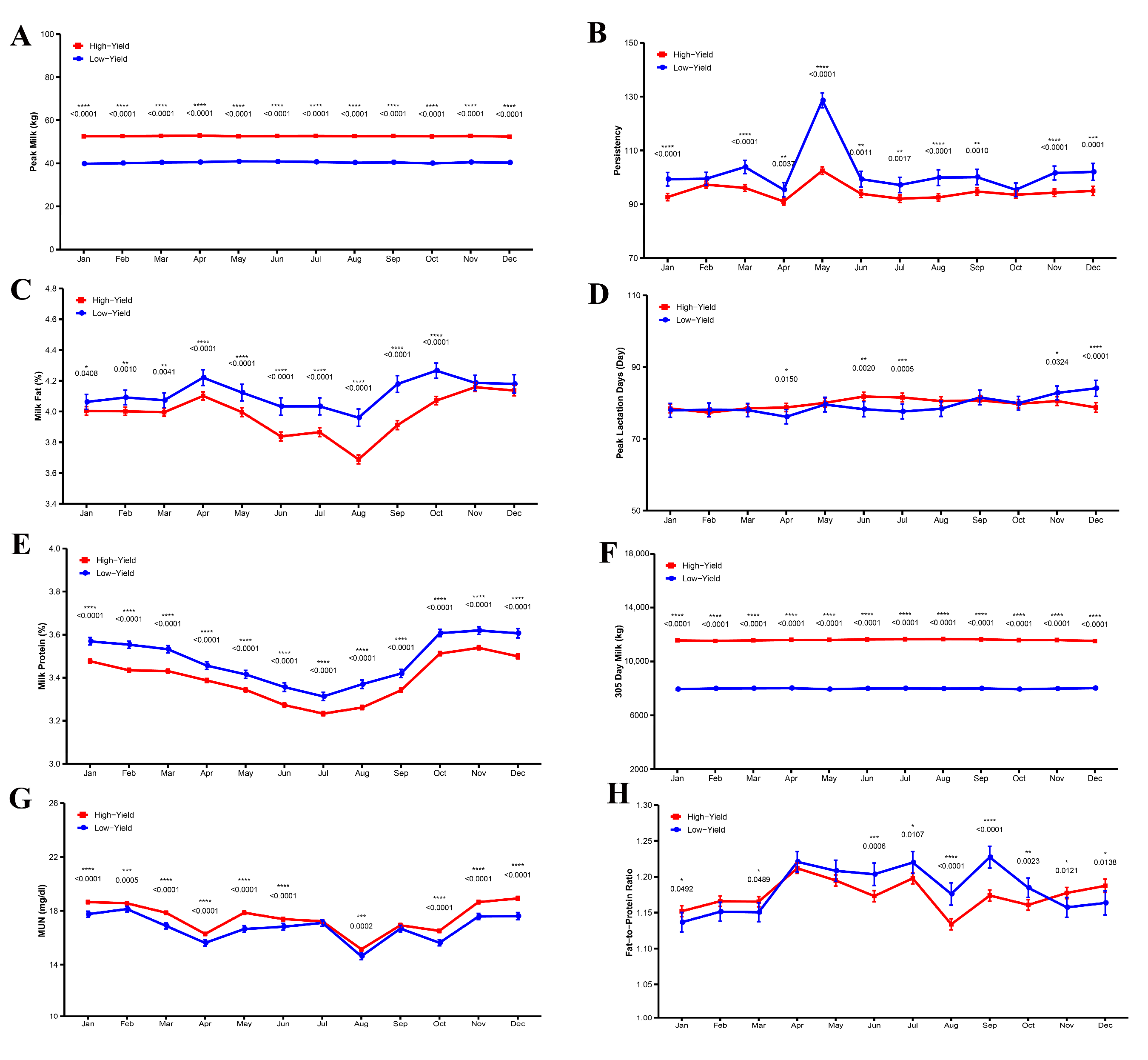
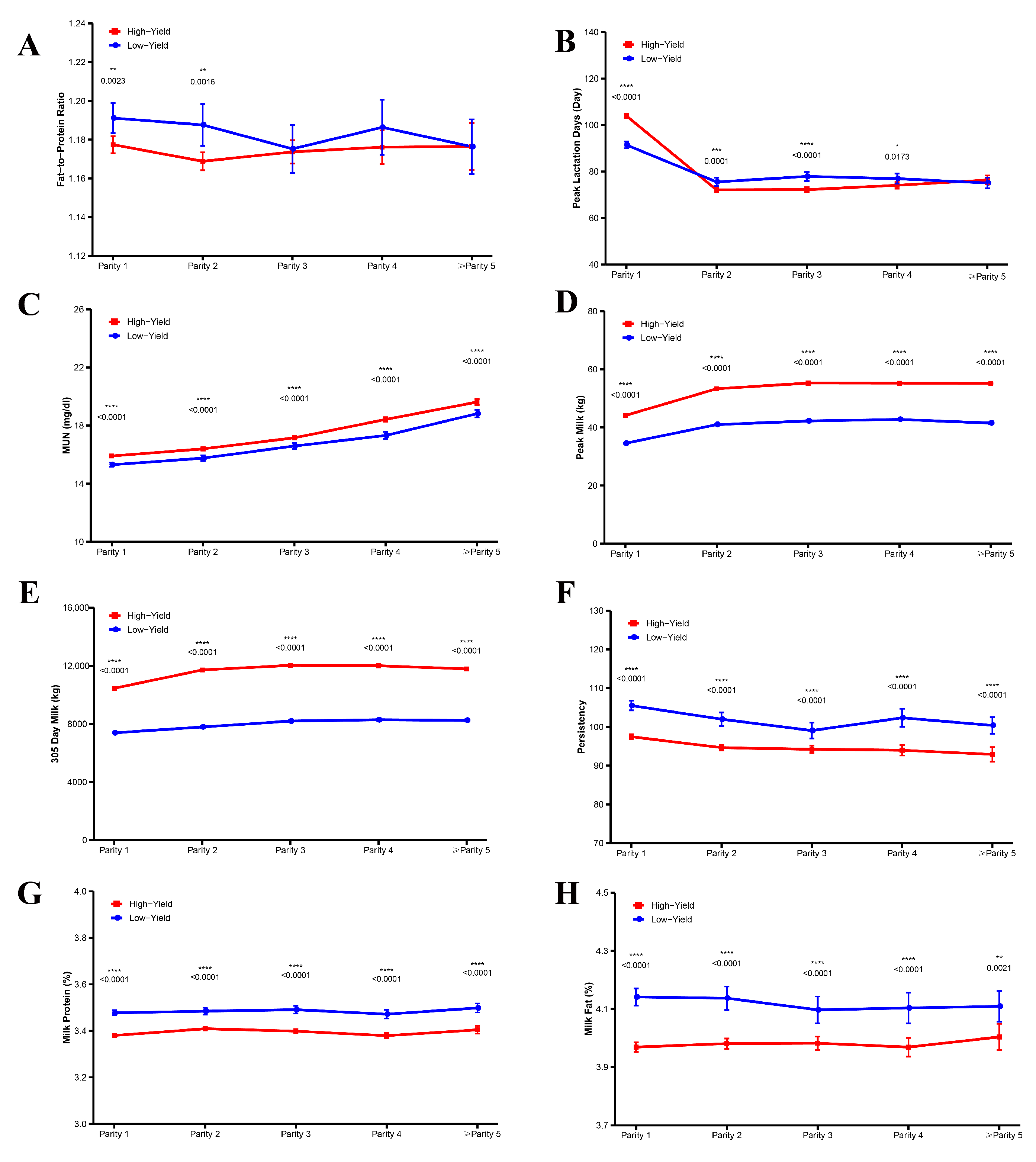
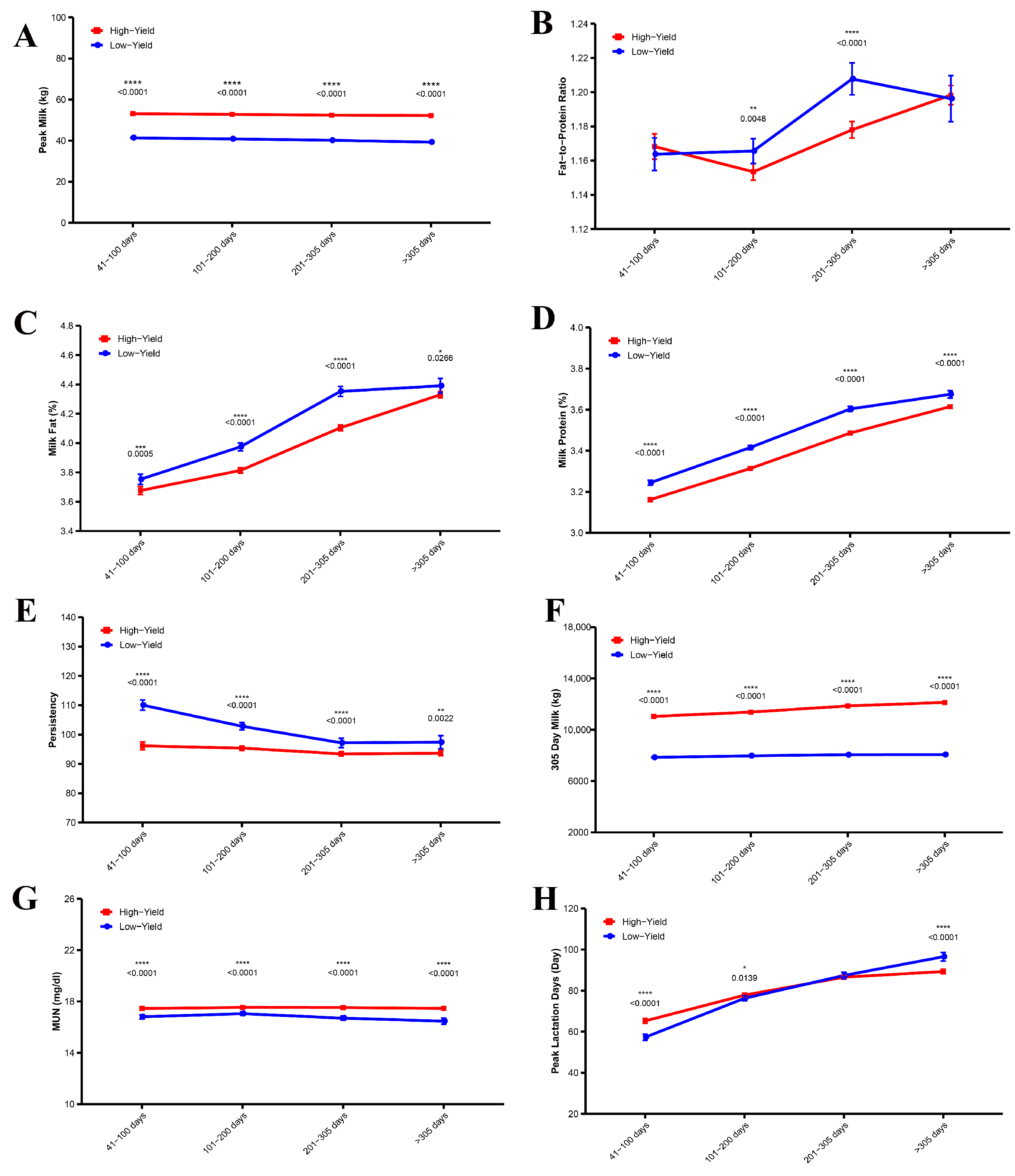
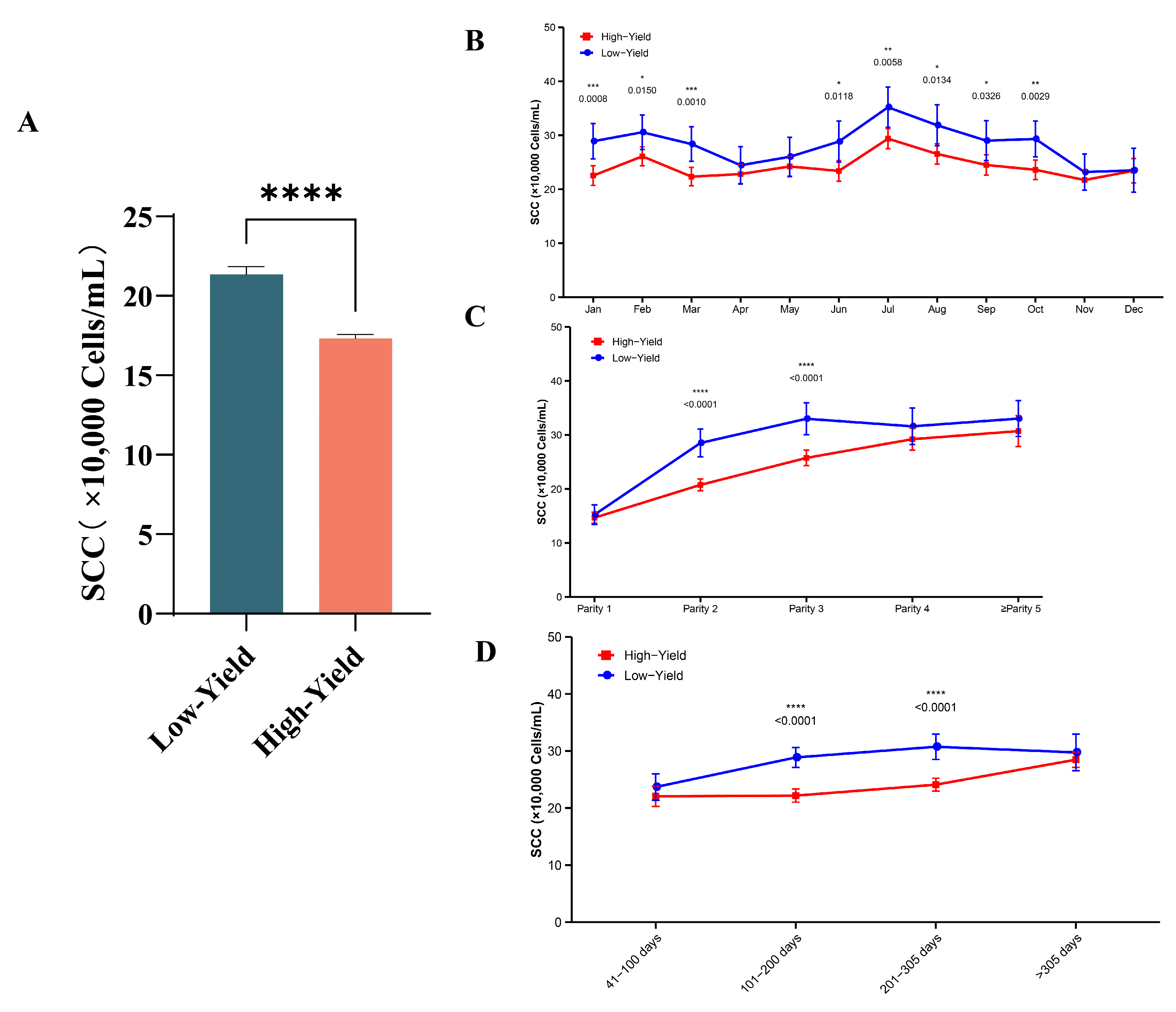

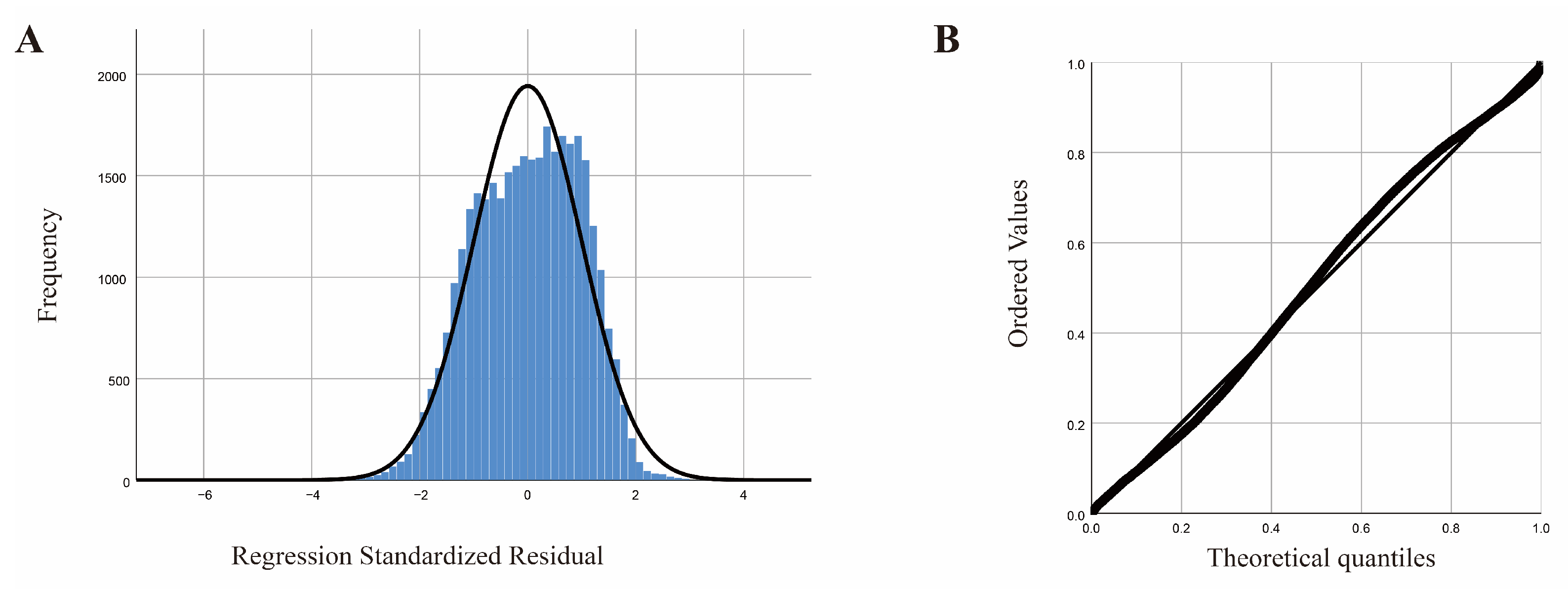
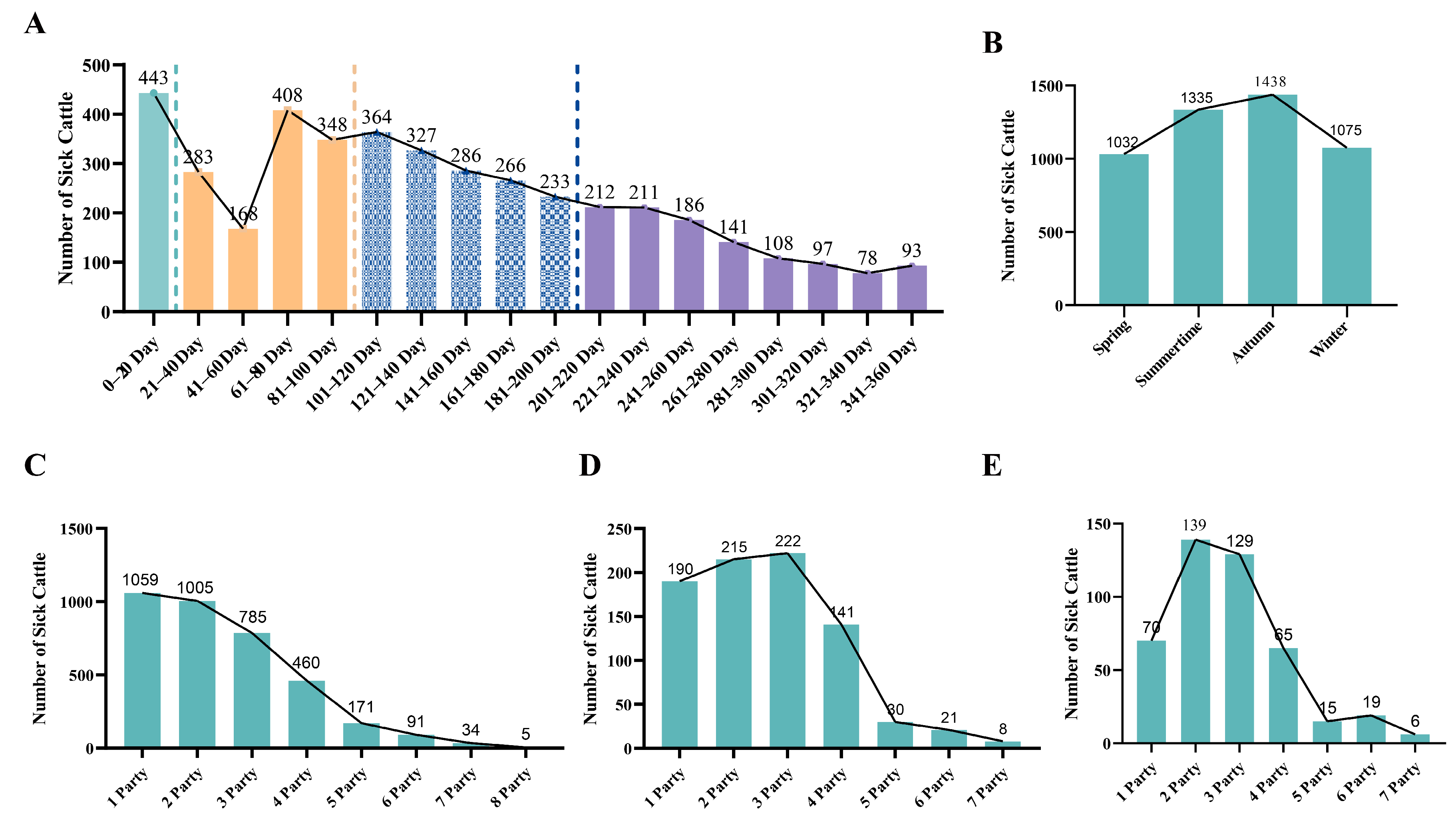
| Ranch | Number of Cows | DHI Date | Bovine Mastitis | |
|---|---|---|---|---|
| n | Time | n | ||
| Ranch A | 2055 | 11,031 | From January 2024 to April 2024 | 4032 |
| Ranch B | 534 | 20,412 | From January 2021 to April 2024 | 223 |
| Ranch C | 940 | 24,389 | From January 2021 to November 2023 | 194 |
| Ranch D | 1425 | 12,489 | From January 2023 to April 2024 | - |
| Ranch E | 2993 | 28,847 | From January 2023 to November 2023 | - |
| Ranch F | 761 | 39,127 | From January 2018 to April 2024 | - |
| Total | 8708 | 136,295 | 4449 | |
| Mean | Standard Deviation | N | |
|---|---|---|---|
| Milk Production (kg) | 1.78 | 0.416 | 26,048 |
| Parity | 2.79 | 1.059 | 26,048 |
| Season | 2.517 | 1.1751 | 26,048 |
| Calving Interval (day) | 393.726 | 69.0979 | 26,048 |
| Lactation Days (day) | 3.23 | 0.702 | 26,048 |
| Milk Fat (%) | 3.89 | 0.917 | 26,048 |
| Milk Protein (%) | 3.33 | 0.345 | 26,048 |
| Fat-to-Protein Ratio (%) | 1.17 | 0.248 | 26,048 |
| Milk Urea Nitrogen (mg/dL) | 16.21 | 3.606 | 26,048 |
| Milk Loss | 0.64 | 1.546 | 26,048 |
| Poor Milk Quality (kg) | 1.18 | 2.896 | 26,048 |
| Economic Loss | 1.851 | 4.5255 | 26,048 |
| Energy Corrected Milk (kg) | 44.967 | 11.7882 | 26,048 |
| Sustaining Force | 99.807 | 51.2047 | 26,048 |
| WHI | 106.060 | 26.3454 | 26,048 |
| Previous Milk Yield (kg) | 42.894 | 10.9668 | 26,048 |
| Previous Somatic Cell Count | 2.352 | 2.0088 | 26,048 |
| Previous Milk Loss (kg) | 0.645 | 1.5981 | 26,048 |
| Peak Milk Yield (kg) | 53.120 | 8.9042 | 26,048 |
| Peak Day (day) | 73.53 | 38.669 | 26,048 |
| 305-Day Milk Yield (day) | 11,463.6427 | 2171.35038 | 26,048 |
| Total Milk Yield (kg) | 8038.2269 | 3349.11376 | 26,048 |
| Total Milk Fat (%) | 303.4076 | 131.60021 | 26,048 |
| Total Milk Protein (%) | 258.03 | 107.919 | 26,048 |
| Mature Equivalent (kg) | 12,057.85 | 2321.335 | 26,048 |
| Model | R | R2 | Adjusted R2 | Standard Error |
|---|---|---|---|---|
| 1 | 0.815 a | 0.665 | 0.665 | 0.241 |
| Sum | Degree of Freedom | Mean Squares | F | p | |
|---|---|---|---|---|---|
| Squares Regression | 3004.389 | 23 | 130.626 | 2245.954 | 0.0001 b |
| Squares Error | 1513.567 | 26,024 | 0.058 | ||
| Total | 4517.956 | 26,047 |
| Unstandardized Coefficients | Standardized Regression Weights | t | p | β 95%CI | |||
|---|---|---|---|---|---|---|---|
| β | s | ||||||
| (Constant) | 1.883 | 0.075 | 25.052 | 0.000 | 1.735 | 2.030 | |
| Parity | −0.012 | 0.003 | −0.030 | −4.522 | 0.000 | −0.017 | −0.007 |
| Season | 0.011 | 0.001 | 0.031 | 8.247 | 0.000 | 0.008 | 0.013 |
| Calving Interval | 0.000 | 0.000 | −0.009 | −2.373 | 0.018 | 0.000 | 0.000 |
| Lactation Days | −0.046 | 0.005 | −0.077 | −9.938 | 0.000 | −0.055 | −0.037 |
| Milk Fat | −0.131 | 0.018 | −0.288 | −7.420 | 0.000 | −0.165 | −0.096 |
| Milk Protein | −0.071 | 0.022 | −0.059 | −3.259 | 0.001 | −0.113 | −0.028 |
| Fat-to-Protein Ratio | −2.549 × 10−1 | 0.057 | −0.152 | −4.452 | 0.000 | −0.367 | −0.143 |
| Milk Urea Nitrogen | 0.000 | 0.000 | 0.000 | 0.073 | 0.941 | −0.001 | 0.001 |
| Milk Loss | −3.538 × 10−3 | 0.007 | −0.013 | −0.509 | 0.611 | −0.017 | 0.010 |
| Poor Milk Quality | 0.003 | 0.004 | 0.023 | 0.874 | 0.382 | −0.004 | 0.011 |
| Economic Loss | 0.031 | 0.000 | 0.875 | 89.940 | 0.000 | 0.030 | 0.032 |
| Energy Corrected Milk | 0.000 | 0.000 | 0.021 | 4.750 | 0.000 | 0.000 | 0.000 |
| Sustaining Force | 0.000 | 0.000 | −0.012 | −1.498 | 0.134 | 0.000 | 0.000 |
| WHI | 0.002 | 0.000 | 0.061 | 7.749 | 0.000 | 0.002 | 0.003 |
| Previous Milk Yield | −0.004 | 0.001 | −0.018 | −2.955 | 0.003 | −0.006 | −0.001 |
| Previous Somatic Cell Count | 0.006 | 0.002 | 0.022 | 3.691 | 0.000 | 0.003 | 0.009 |
| Previous Milk Loss | −0.006 | 0.000 | −0.136 | −18.511 | 0.000 | −0.007 | −0.006 |
| Peak Milk Yield | −0.001 | 0.000 | −0.055 | −13.906 | 0.000 | −0.001 | −0.001 |
| Peak Day | 0.000 | 0.000 | 0.936 | 19.927 | 0.000 | 0.000 | 0.000 |
| 305-Day Milk Yield | 0.000 | 0.000 | −0.478 | −23.860 | 0.000 | 0.000 | 0.000 |
| Total Milk Yield | 0.000 | 0.000 | 0.066 | 5.462 | 0.000 | 0.000 | 0.000 |
| Total Milk Fat | −3.805 × 10−4 | 0.000 | −0.099 | −5.287 | 0.000 | −0.001 | 0.000 |
| Total Milk Protein | 0.000 | 0.000 | −0.711 | −15.478 | 0.000 | 0.000 | 0.000 |
| Mean | Standard Deviation | N | |
|---|---|---|---|
| Somatic Cell Count | 2.60 | 1.991 | 34,068 |
| Parity | 2.83 | 1.106 | 34,068 |
| Season | 2.505 | 1.1742 | 34,068 |
| Calving Interval (day) | 392.639 | 68.4728 | 34,068 |
| Lactation Days (day) | 3.32 | 0.697 | 34,068 |
| Milk Fat (%) | 3.96 | 0.931 | 34,068 |
| Milk Protein (%) | 3.37 | 0.356 | 34,068 |
| Fat-to-Protein Ratio (%) | 1.18 | 0.247 | 34,068 |
| Milk Urea Nitrogen (mg/dL) | 16.07 | 3.640 | 34,068 |
| Milk Loss | 0.60 | 1.451 | 34,068 |
| Poor Milk Quality (kg) | 1.12 | 2.717 | 34,068 |
| Economic Loss | 1.745 | 4.2446 | 34,068 |
| Energy Corrected Milk (kg) | 41.860 | 13.4291 | 34,068 |
| Sustaining Force | 96.220 | 52.6455 | 34,068 |
| WHI | 99.672 | 30.0559 | 34,068 |
| Previous Milk Yield (kg) | 40.319 | 11.9245 | 34,068 |
| Previous Somatic Cell Count | 2.448 | 2.0046 | 34,068 |
| Previous Milk Loss (kg) | 0.624 | 1.5260 | 34,068 |
| Peak Milk Yield (kg) | 51.775 | 9.5294 | 34,068 |
| Peak Day (day) | 73.00 | 39.327 | 34,068 |
| 305-Day Milk Yield (day) | 11,142.4294 | 2326.53864 | 34,068 |
| Total Milk Yield (kg) | 8142.1513 | 3364.16667 | 34,068 |
| Total Milk Fat (%) | 308.9372 | 132.97144 | 34,068 |
| Total Milk Protein (%) | 263.01 | 108.860 | 34,068 |
| Mature Equivalent (kg) | 11,714.67 | 2482.893 | 34,068 |
| Model | R | R2 | Adjusted R2 | Standard Error |
|---|---|---|---|---|
| 1 | 0.806 a | 0.650 | 0.650 | 1.178 |
| Sum | Degree of Freedom | Mean Squares | F | p | |
|---|---|---|---|---|---|
| Squares Regression | 87,780.873 | 23 | 3816.560 | 2748.199 | 0.0001 b |
| Squares Error | 47,278.586 | 34,044 | 1.389 | ||
| Total | 135,059.459 | 34,067 |
| Unstandardized Coefficients | Standardized Regression Weights | t | p | β 95%CI | |||
|---|---|---|---|---|---|---|---|
| β | s | ||||||
| (Constant) | −0.582 | 0.318 | −1.828 | 0.068 | −1.206 | 0.042 | |
| Parity | 0.042 | 0.010 | 0.024 | 4.223 | 0.000 | 0.023 | 0.062 |
| Season | −0.022 | 0.006 | −0.013 | −3.981 | 0.000 | −0.033 | −0.011 |
| Calving Interval | 0.000 | 0.000 | 0.006 | 1.941 | 0.052 | 0.000 | 0.000 |
| Lactation Days | 0.055 | 0.020 | 0.019 | 2.786 | 0.005 | 0.016 | 0.093 |
| Milk Fat | −0.009 | 0.074 | −0.004 | −0.124 | 0.901 | −0.154 | 0.135 |
| Milk Protein | 0.602 | 0.091 | 0.108 | 6.581 | 0.000 | 0.423 | 0.781 |
| Fat-to-Protein Ratio | 7.471 × 10−1 | 0.242 | 0.093 | 3.088 | 0.002 | 0.273 | 1.221 |
| Milk Urea Nitrogen | −0.026 | 0.002 | −0.047 | −13.577 | 0.000 | −0.029 | −0.022 |
| Milk Loss | 1.163 × 100 | 0.032 | 0.847 | 36.840 | 0.000 | 1.101 | 1.225 |
| Poor Milk Quality | −0.090 | 0.017 | −0.122 | −5.304 | 0.000 | −0.123 | −0.056 |
| Economic Loss | −0.019 | 0.001 | −0.130 | −14.697 | 0.000 | −0.022 | −0.017 |
| Energy Corrected Milk | 0.000 | 0.000 | −0.008 | −1.927 | 0.054 | −0.001 | 0.000 |
| Sustaining Force | −0.003 | 0.001 | −0.044 | −5.766 | 0.000 | −0.004 | −0.002 |
| WHI | 0.000 | 0.001 | 0.000 | −0.062 | 0.950 | −0.002 | 0.002 |
| Previous Milk Yield | 0.219 | 0.005 | 0.220 | 41.844 | 0.000 | 0.209 | 0.229 |
| Previous Somatic Cell Count | −0.155 | 0.007 | −0.119 | −22.957 | 0.000 | −0.168 | −0.142 |
| Previous Milk Loss | 0.007 | 0.001 | 0.034 | 4.948 | 0.000 | 0.004 | 0.010 |
| Peak Milk Yield | 0.000 | 0.000 | 0.008 | 2.447 | 0.014 | 0.000 | 0.001 |
| Peak Day | 0.000 | 0.000 | −0.171 | −3.996 | 0.000 | 0.000 | 0.000 |
| 305-Day Milk Yield | 0.000 | 0.000 | 0.154 | 8.693 | 0.000 | 0.000 | 0.000 |
| Total Milk Yield | −0.001 | 0.000 | −0.062 | −5.878 | 0.000 | −0.001 | −0.001 |
| Total Milk Fat | 9.262 × 10−4 | 0.000 | 0.051 | 3.101 | 0.002 | 0.000 | 0.002 |
| Total Milk Protein | 0.000 | 0.000 | 0.109 | 2.623 | 0.009 | 0.000 | 0.000 |
Disclaimer/Publisher’s Note: The statements, opinions and data contained in all publications are solely those of the individual author(s) and contributor(s) and not of MDPI and/or the editor(s). MDPI and/or the editor(s) disclaim responsibility for any injury to people or property resulting from any ideas, methods, instructions or products referred to in the content. |
© 2025 by the authors. Licensee MDPI, Basel, Switzerland. This article is an open access article distributed under the terms and conditions of the Creative Commons Attribution (CC BY) license (https://creativecommons.org/licenses/by/4.0/).
Share and Cite
Zhou, Q.; Geng, Z.; Lian, S.; Wang, J.; Wu, R. Analysis of Lactation Performance and Mastitis Incidence in High- and Low-Yielding Dairy Cows Using DHI Data. Animals 2025, 15, 2495. https://doi.org/10.3390/ani15172495
Zhou Q, Geng Z, Lian S, Wang J, Wu R. Analysis of Lactation Performance and Mastitis Incidence in High- and Low-Yielding Dairy Cows Using DHI Data. Animals. 2025; 15(17):2495. https://doi.org/10.3390/ani15172495
Chicago/Turabian StyleZhou, Qijun, Zijian Geng, Shuai Lian, Jianfa Wang, and Rui Wu. 2025. "Analysis of Lactation Performance and Mastitis Incidence in High- and Low-Yielding Dairy Cows Using DHI Data" Animals 15, no. 17: 2495. https://doi.org/10.3390/ani15172495
APA StyleZhou, Q., Geng, Z., Lian, S., Wang, J., & Wu, R. (2025). Analysis of Lactation Performance and Mastitis Incidence in High- and Low-Yielding Dairy Cows Using DHI Data. Animals, 15(17), 2495. https://doi.org/10.3390/ani15172495





